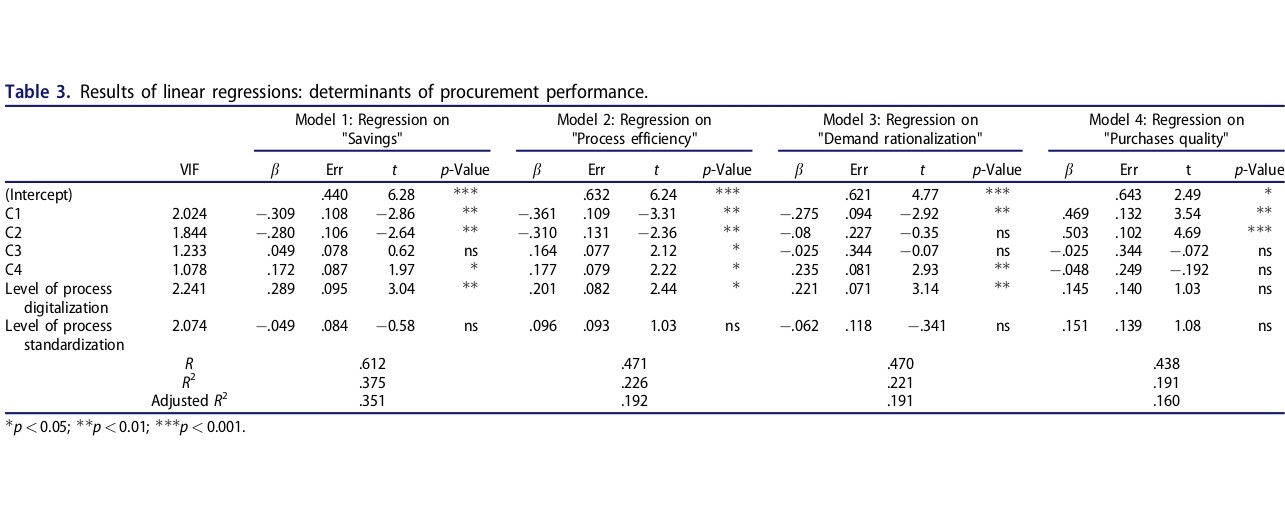Introduction
Nowadays, multiple regression (MLR) is believed to be an efficient means of analysis of independent configurations. The article under consideration aims at finding the correlation between centralization, digitalization, and structuralization in terms of public procurement. Thus, the authors provide the results attached as a table. By use of MLR, they try to prove that digitalization serves as the most important component to optimize public procurement, whereas structuralization plays no sufficient role in it. As far as centralization is concerned, it has both positive and negative effects on the issue.
Discussion
Actually, it would be reasonable to dwell on the reason why the authors used multiple regression. First of all, centralization, digitalization, and structuralization as economic factors are unlikely to have any visible connection. According to the article, “knowledge about public procurement configuration is still incomplete; many studies investigate the topic with a distinct focus on the private sector” (as cited from Bals, et al., 2018), “but it is questionable if findings fully apply to public administration. A second research gap exists because existing literature on the topic often adopts a country-wide perspective” (as cited from Wang & Li, et al., 2014). Therefore, the regression equation and its statistical significance may be easily shown by the use of a chart.
Secondly, multiple regression is widely used; its principles can be learned and applied without particular knowledge of mathematics. However, some researchers claim that “to fit the entire moderated multiple-regression model in single, rather than separate steps to avoid the interpretation error” (Vancouver, Carlson, Dhanani, et al., 2021). On the one hand, there is truth in the fact that MLR results may be misinterpreted because this type of analysis seems to be rather a rough one. The results of structuralization having practically no impact on public procurement should be better reconverted. There is a strong possibility of a mistake in this point, judging by common sense. On the other hand, the most important thing was to find a correlation, not to investigate every single point in detail. Thus, the choice of methodology seems to be accurate.
The researchers report effect size that can be observed in the regression report. The results “show that, for savings, there is a positive correlation with the most centralized form (C4: bj0.172, p<0.05) and the level of digitalization (bj0.289, p<0.01), while the adoption of more decentralized forms has, instead, a negative relationship with savings (b j _0.309, p<0.01 for C1; b j _0.280, p<0.01 for C2). No significant relationship is found for the C3 centralization option. Similar results are obtained for the process efficiency, which is positively linked to the most centralized forms (bj0.177, p<0.05 for C4; bj0.164, p<0.05 for C3) and the level of digitalization (bj0.201, p<0.05), while negatively related to the decentralized forms (b j _0.361, p<0.01 for C1; b j _0.310, p<0.01 for C2). The situation is slightly different for the demand rationalization, which is positively linked to both the most centralized form (C4: bj0.235, p<0.01) and the level of digitalization (bj0.221, p<0.05) but negatively related to the adoption of the most decentralized configuration (C1: b j_0.275, p<0.05). No significant relationships are found for the hybrid forms (C2 and C3). Completely opposite are the results for the purchases quality, which is strongly and positively related to the most decentralized configurations (bj0.469, p<0.01 for C1; bj0.503, p<0.001 for C2), while no significant relationships are found for the other variables. The level of standardization does not appear as a statistically significant variable in any of the models” (Patrucco, Agasisti, Glas, et al., 2021).
Indeed, authors display the precise data that deserves special attention. To go deeper in the analysis, one should understand what stands for the terms “centralization, digitalization and structuralization”. To make it easier, the definitions are merged into one long quotation: “centralization refers to the extent to which responsibilities on procurement activities are concentrated within a department as opposed to being spread across several offices. The level of standardization measures to what extent the activities of the procurement process are precisely defined in formal documents describing rules, procedures, and policies. The level of digitalization measures how much the different phases of the procurement process are supported by technologies” (as cited from Albano & Sparro, 2010). The correlation of these factors is profoundly described both in the regression report and in the chart.
In fact, the authors have shown the data effectively in both tabular and graphical means. By quickly studying it, the reader may associate the results with the formulated hypothesis and resort to critical thinking of the displayed data. The results are shown in the following chart:

Conclusion
To sum it up, it is no easy matter to perform in economics. To make the process of finding the results easier, researchers usually resort to multiple regression. MLR has many advantages but cannot be referred as the most accurate means of analysis because it leaves much area for interpretation. Therefore, it is not surprising that the value of structuralization was diminished. Still, digitalization and centralization seem to have been appropriately estimated. It can be referred that the results stand alone because they add to existing statistical knowledge. Moreover, the article provides methods, the use of that can be advocated in the process of calculating the effect sizes in multiple regression. Thus, the article is worth of reading for people interested in statistics.
References
Roberts, A., Roberts, M. J. (2020). Multiple regression: A practical introduction. SAGE Publications.
Vancouver, J. B., Carlson, B. W., Dhanani, L. Y., & Colton, C. E. (2021). Interpreting moderated multiple regression: A comment on Van Iddekinge, Aguinis, Mackey, and DeOrtentiis (2018). Journal of Applied Psychology, 106(3), 467–475. Web.
Patrucco, A. S., Agasisti, T., & Glas, A. H. (2021). Structuring public procurement in local governments: The effect of centralization, standardization and digitalization on performance. Taylor & Francis Group, 44(3), 630-656. Web.